
 |
 |
 |
 |
 |
 |
 |
 |
 |
|
|
#1 |
|
Canyon Carver
Join Date: Nov 2009
Location: FLooRi.D.A.
Moto: gsx-r750
Posts: 378
|
Power Is Nothing Without Control
Newer. Faster. Lighter. Better. You hear these descriptors all the time in this business. Problem is, reality rarely lives up to the hype. But Kawasaki’s new-from-the-ground-up 2011 Ninja® ZX™-10R sportbike has no such credibility gap, going several steps beyond newer, faster, lighter and better by offering the most advanced traction-control system in all of production motorcycling. Yes, in all of production motorcycling. 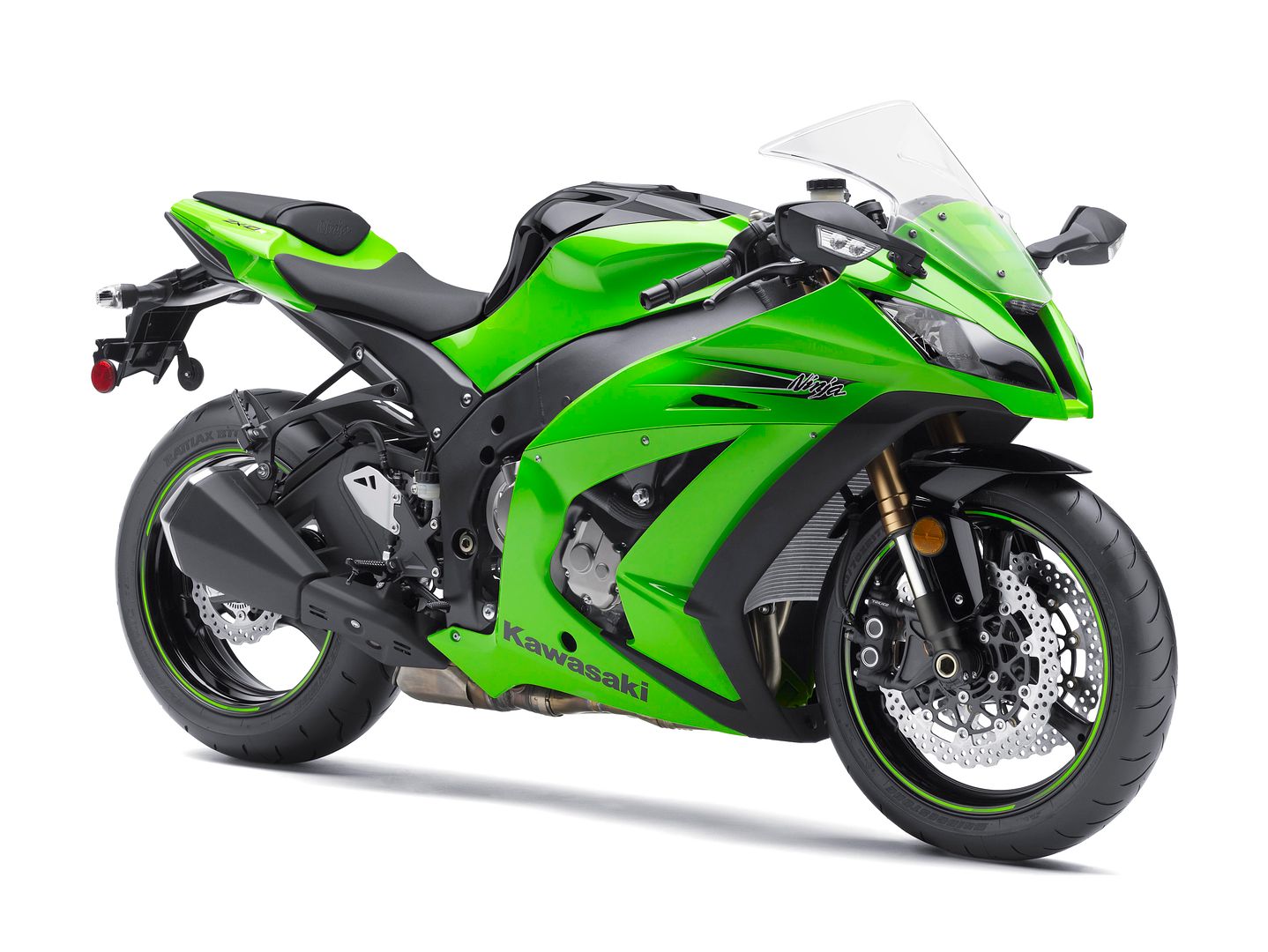 Not only are we talking about a complete redesign of the ZX-10R’s engine, frame, suspension, bodywork, instrumentation and wheels, but a highly advanced and customizable electronic system that helps riders harness and capitalize on the new ZX-10R’s amazing blend of power and responsive handling. The system is called Sport-Kawasaki Traction Control, or S-KTRC. It represents a whole new dimension in motorcycle performance, and the ZX-10R is the only production sport bike that can take you there. Motorcyclists have forever been challenged by traction-related issues, whether on dirt, street or track. Riders that can keep a rear tire from spinning excessively or sliding unpredictably are both faster and safer, a tough combination to beat on the racetrack. And when talking about the absolute leading edge of open-class sport bike technology, where production street bikes are actually more capable than full-on race bikes from just a couple years ago, more consistent traction and enhanced confidence is a major plus. The MotoGP-derived S-KTRC system works by crunching numbers from a variety of parameters and sensors – wheel speed and slip, engine rpm, throttle position, acceleration, etc. There’s more data gathering and analysis going on here than on any other Kawasaki in history, and it’s all in the name of helping racers inch closer to the elusive “edge” of maximum traction than ever before. The S-KTRC system relies on complex software buried in the new ZX-10R’s Electronic Control Unit (ECU), the only additional hardware is the lightweight speed sensors located on each wheel. 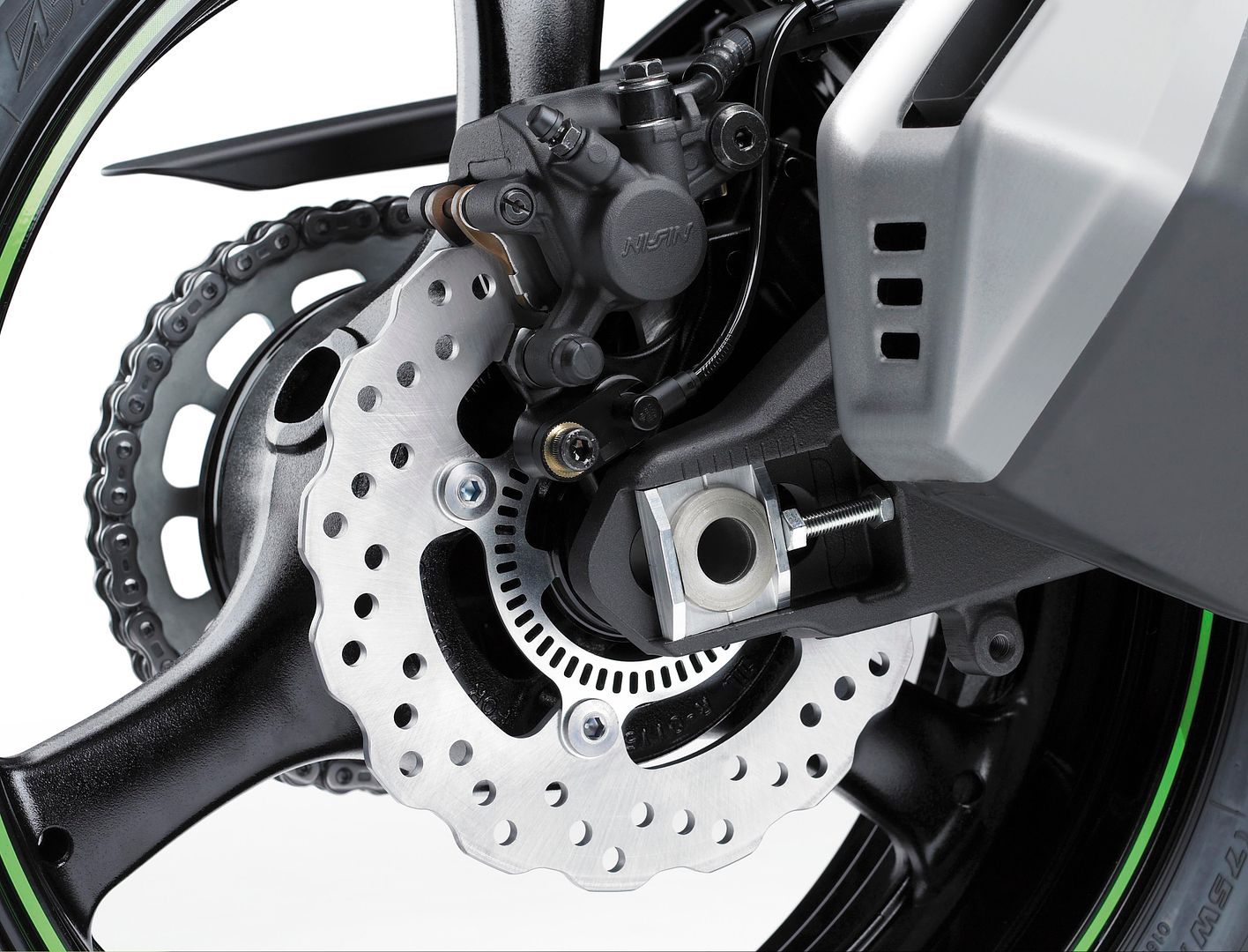 Unlike the KTRC system on Kawasaki’s Concours™ 14 ABS sport tourer, which primarily minimizes wheel slip on slick or broken surfaces as a safety feature, the S-KTRC system is designed to maximize performance by using complex analysis to predict when traction conditions are about to become unfavorable. By quickly, but subtly reducing power just before the amount of slippage exceeds the optimal traction zone, the system – which processes every data point 200 times per second – maintains the optimum level of tire grip to maximize forward motion. The result is significantly better lap times and enhanced rider confidence –exactly what one needs when piloting a machine of this caliber. 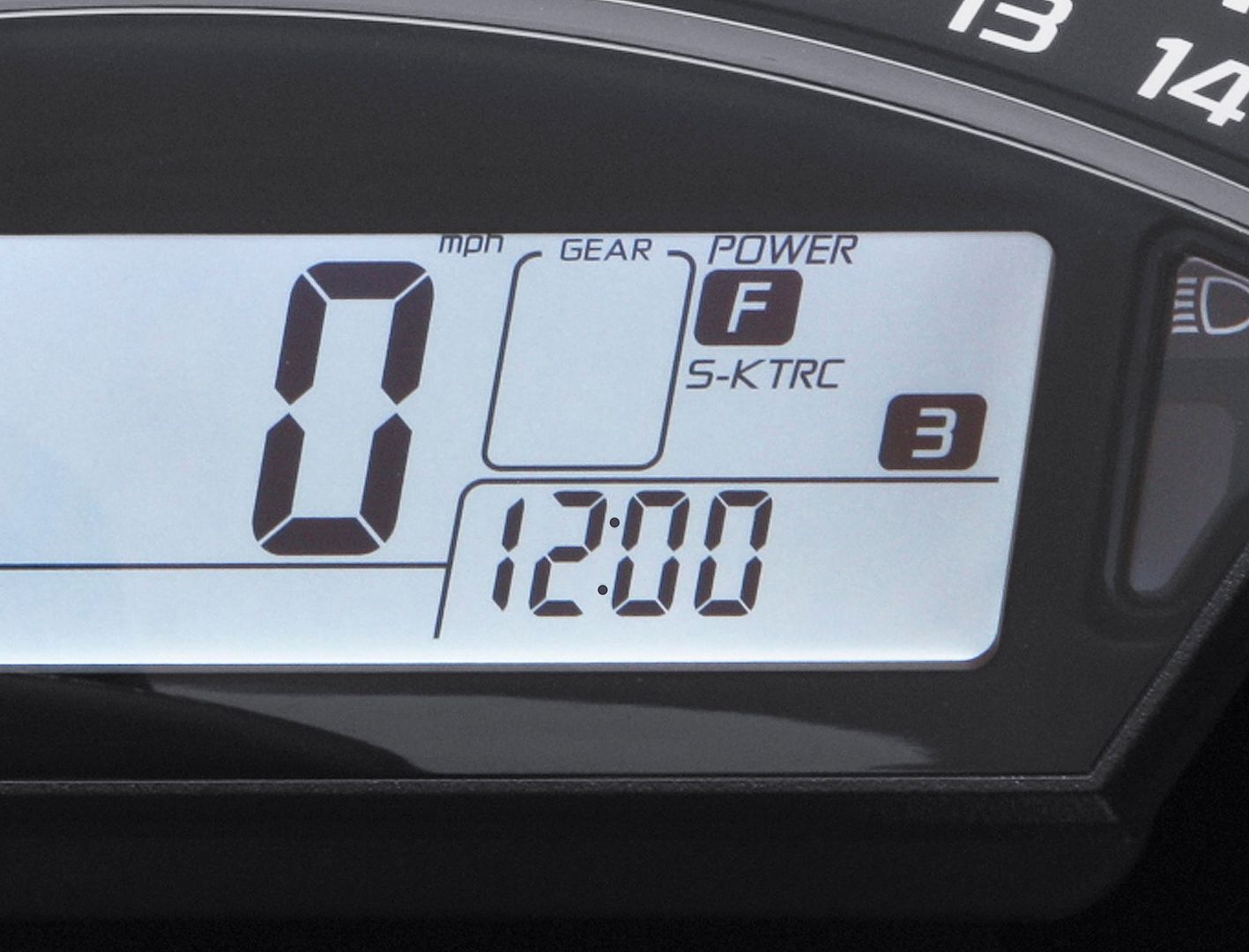 The S-KTRC system offers three different modes of operation, which riders can select according to surface conditions, rider preference and skill level: Level 1 for max-grip track use, Level 2 for intermediate use, and Level 3 for slippery conditions. An LCD graph in the newly designed instrument cluster displays how much electronic intervention is occurring in real time and a thumb switch on the left handlebar pod allows simple, on-the-go mode changes.  The system also incorporates an advanced Power Mode system that allows riders to choose the amount of power – and the character of delivery – available from the engine. Besides the standard Full-power mode are Medium and Low settings. In Medium mode, performance varies according to throttle position and engine rpm; at anything less than 50 percent throttle opening, performance is essentially the same as in Low mode; at more than 50 percent, riders can access additional engine performance. All three S-KTRC settings are available in each of the three Power Mode settings. And the motorcycle so capably managed by all of this trick electronic wizardry? It’s completely redesigned from 2010 to ’11. It all starts with the 10R’s all-new inline-four, easily the most advanced engine to ever emerge from a Kawasaki factory. Like last year’s potent ZX-10R engine, the new powerplant is a 16-valve, DOHC, liquid-cooled inline-four displacing 998cc via 76 x 55mm bore and stroke dimensions. But that’s where the similarity stops, as the new mill boasts a handful of engineering changes designed to optimize power delivery, center of gravity and actual engine placement within the chassis. A primary goal of Kawasaki engineers was linear power delivery and engine manageability throughout all elements of a corner: the entry, getting back to neutral throttle at mid-corner, and heady, controllable acceleration at the exit. Peak torque was moved to a higher rpm range, which eliminates the power peaks and valleys that make it difficult for racers and track-day riders to open the throttle with confidence. Larger intake valves (31mm vs. 30mm), wider– and polished – intake ports, and completely revised exhaust porting all allow better breathing, more controllable power delivery and less engine braking, just the thing to smooth those racetrack corner entries and exits. Higher-lift camshafts built from lighter-yet-stronger chromoly steel (instead of cast iron) and featuring revised overlap further contribute to optimized engine braking and more controllable power delivery. Newly designed lightweight pistons feature shorter skirts and mount to lighter and stronger connecting rods, each of which spin a revised crankshaft made of a harder material and featuring stronger pins and journal fillets. Compression moves to a full 13.0:1. There’s more, including a totally revamped crankshaft/transmission shaft layout that contributes to a higher center of mass – and improved handling via better mass centralization – by locating the crankshaft approximately 10 degrees higher relative to the output shaft. There’s even a secondary engine balancer assembly this year, which allows a number of vibration-damping parts to be simplified, contributing to weight savings. A smaller and dramatically lighter battery helps drop even more weight, as does a lighter ECU and fuel pump. A race-style cassette transmission allows simple trackside ratio changes and offers a host of improvements for 2011. These include closer spacing for 4th, 5th and 6th gears and the fine-tuning of the primary and final reduction ratios for less squat/lift during acceleration and deceleration, which allows more precise suspension tuning in back. An adjustable back-torque limiting clutch assembly is fitted, which allows worry-free downshifts and an even higher level of corner-entry calmness. Cramming all that fuel and air into this amazing new engine is a ram air-assisted fuel injection system featuring larger throttle bodies (47 vs. 43mm) and sub-throttle valves, a larger-capacity airbox (9 vs. 8 liters), secondary injectors that improve top-end power characteristics, and a large, redesigned ram-air intake that’s positioned closer to the front of the bike for more efficient airbox filling and increased power. The final piece of the ZX-10R’s power-production formula is a race-spec exhaust system featuring a titanium header assembly, hydroformed collectors, a large-volume pre-chamber containing two catalyzers and a highly compact silencer. Due to the header’s race-spec design, riders and racers looking for more closed-course performance need only replace the slip-on muffler assembly. With the engine producing a massive quantity of usable and controllable power, engineers looked to the chassis to help refine handling and overall road/track competency even further. An all-new aluminum twin-spar frame was designed, an all-cast assemblage of just seven pieces that features optimized flex characteristics for ideal rider feedback, cornering performance and lighter weight than last year’s cage. Fewer pieces mean fewer welds, which contributes to a cleaner, more aesthetically pleasing look. Like the frame, the new alloy swingarm is an all-cast assembly, with idealized rigidity matching that of the frame itself.  Chassis geometry was juggled to offer the best possible stability and handling quickness. Rake, at 25 degrees, is a half-degree steeper than on the 2010 machine, while trail has been reduced from 110 to 107mm. This slightly more radical front end geometry, and the quicker, lighter handling it allows, was made possible largely by the new engine’s more controllable power, engine placement and the CG differences it generated, and the frame and swingarm’s newfound flex characteristics. Highly advanced suspension at both ends helped as well. Up front is a 43mm open-class version of the Big Piston Fork (BPF) found on last year’s comparo-dominating Ninja ZX-6R. Featuring a piston design nearly twice the size of a conventional cartridge fork, the BPF offers smoother action, less stiction, lighter overall weight and enhanced damping performance on the compression and rebound circuits. This added compliance results in more control and feedback for the rider – just what you need when carving through a rippled sweeper at your local track or negotiating a decreasing-radius corner on your favorite backroad. There’s big suspension news in back, too. Replacing the vertical Uni-Trak® system of the 2010 ZX-10R is a Horizontal Back-Link suspension design that positions the shock and linkage above the swingarm. Benefits include better mass centralization, improved road holding, compliance and stability, smoother action in the mid-stroke (even with firmer settings), better overall feedback and cooler running. The design also frees space previously taken by the linkage assembly below the swingarm, space now used for the exhaust pre-chamber, which allows a shorter muffler and, again, better mass centralization. The fully adjustable shock features a piggyback reservoir and dual-range (low- and high-speed) compression damping. 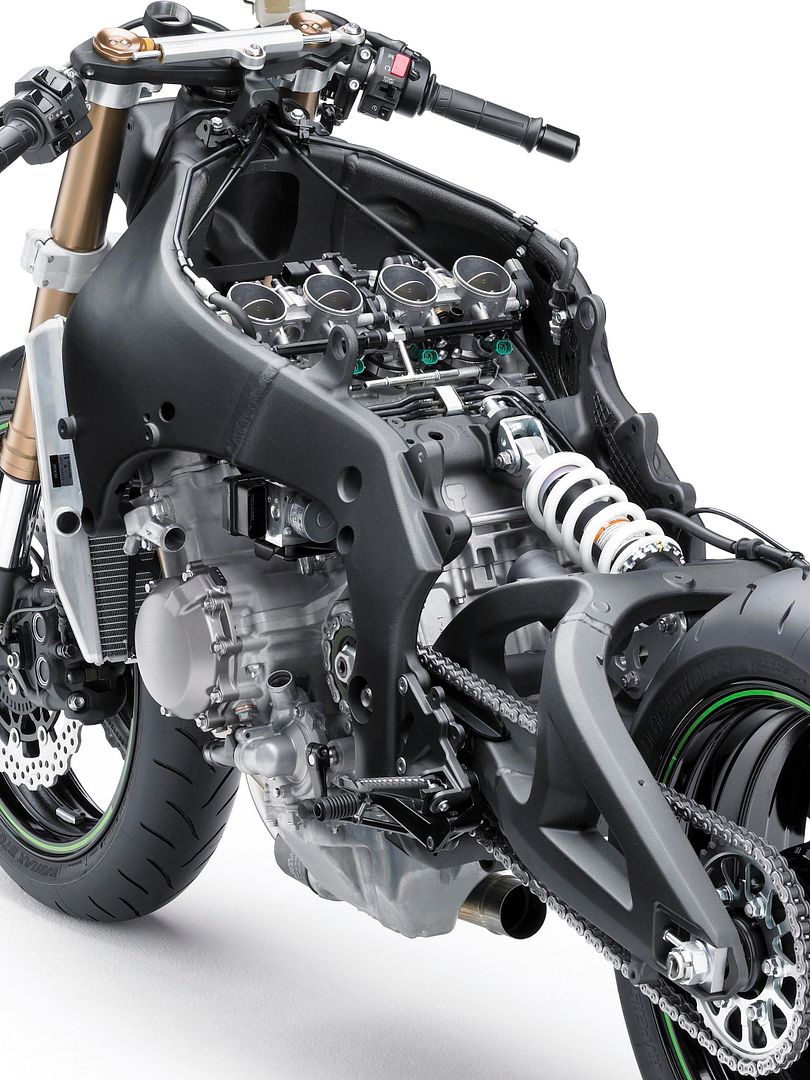 All-new gravity-cast three-spoke wheels are significantly lighter than the hoops fitted to the 2010 bike. Up front, Tokico radial-mount calipers grasp 310mm petal discs and a 220mm disc is squeezed by a lightweight single-piston caliper in back. The result is powerful, responsive braking plenty of rider feedback. Finally, Kawasaki engineers wrapped all this new technology in bodywork as advanced and stylish as anything on this side of a MotoGP grid. Shapes are more curved than edged this year, and the contrasting colored and black parts create a sharp, aggressive image. Line-beam headlights enable the fairing to be made shorter, while LED turn signals are integrated into the mirror assemblies and convenient turn-signal couplers allow easy mirror removal for track-day use. The rear fender assembly holding the rear signal stalks and license plate frame is also easily removable for track days. High-visibility LED lamps are also used for the taillight and position marker.  Instrumentation is totally new as well, the unit highlighted by an LED-backlit bar-graph tachometer set above a multi-featured LCD info screen with numerous sections and data panels. A wide range of information is presented, including vehicle speed, odometer, dual trip meters, fuel consumption, Power Mode and S-KTRC level, low fuel, water temperature and much more. For track use, the LCD display can be set to “race” mode which moves the gear display to the center of the screen. 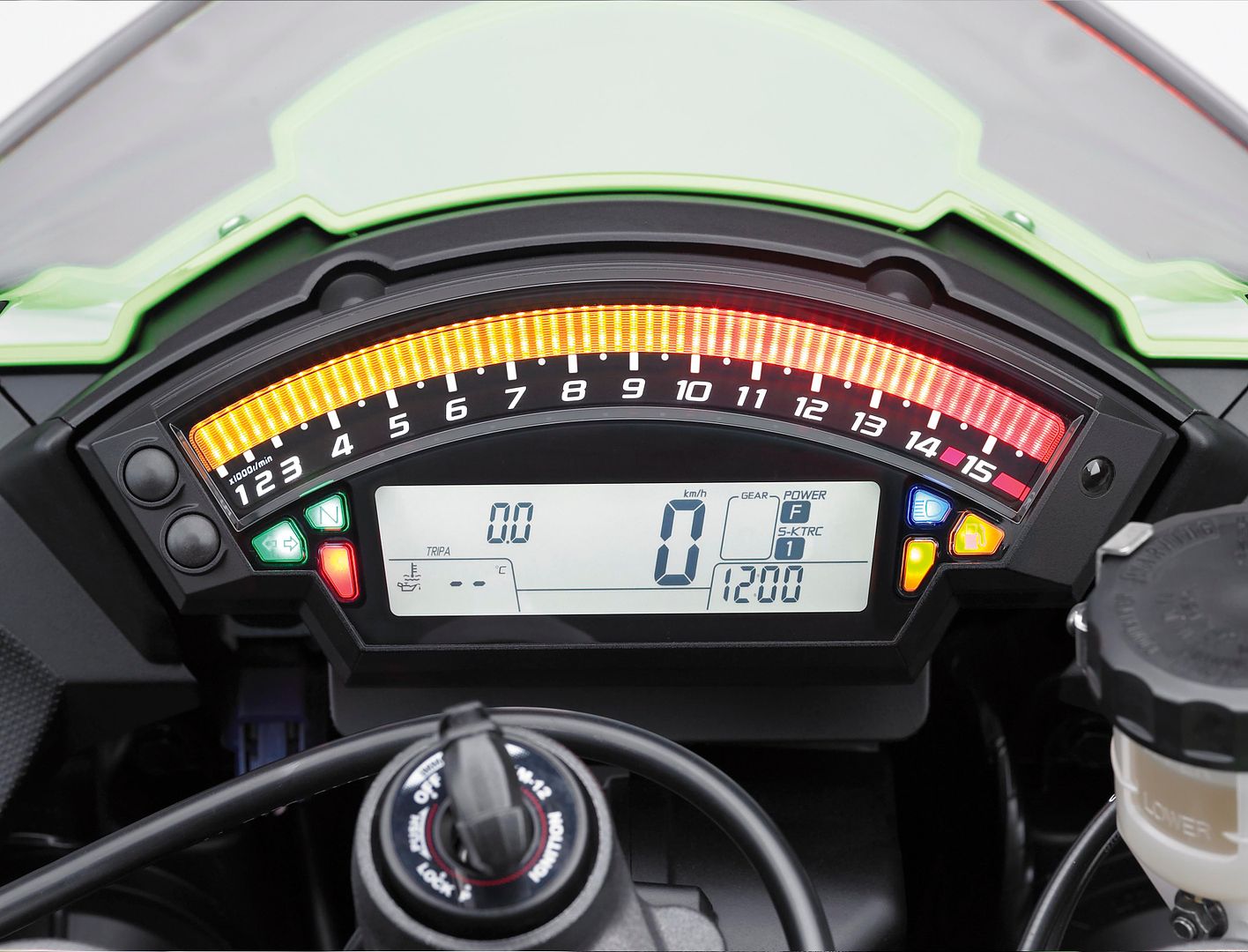 The new ZX-10R’s ergonomics have been fine tuned for optimum comfort and control, with a slightly lower saddle, adjustable footpegs positioned slightly lower and more forward relative to last year, and clip-ons with a bit less downward angle. This is a hard-core sportbike you can actually take on an extended sport ride – and still be reasonably comfortable doing so. And because it’s 22 pounds lighter than last year’s bike, the new ZX-10R will be quicker and more nimble in any environment you choose to ride it in. The old saying, “power is nothing without control” is certainly apt where open-class sport bikes are concerned. But when you factor in all the engine, chassis and ergonomic control designed into the 2011 Ninja ZX-10R, you begin to realize you’re looking at one very special motorcycle – one that can take you places you’ve never been before. Newer. Faster. Lighter. And better. Reality really does match the hype. 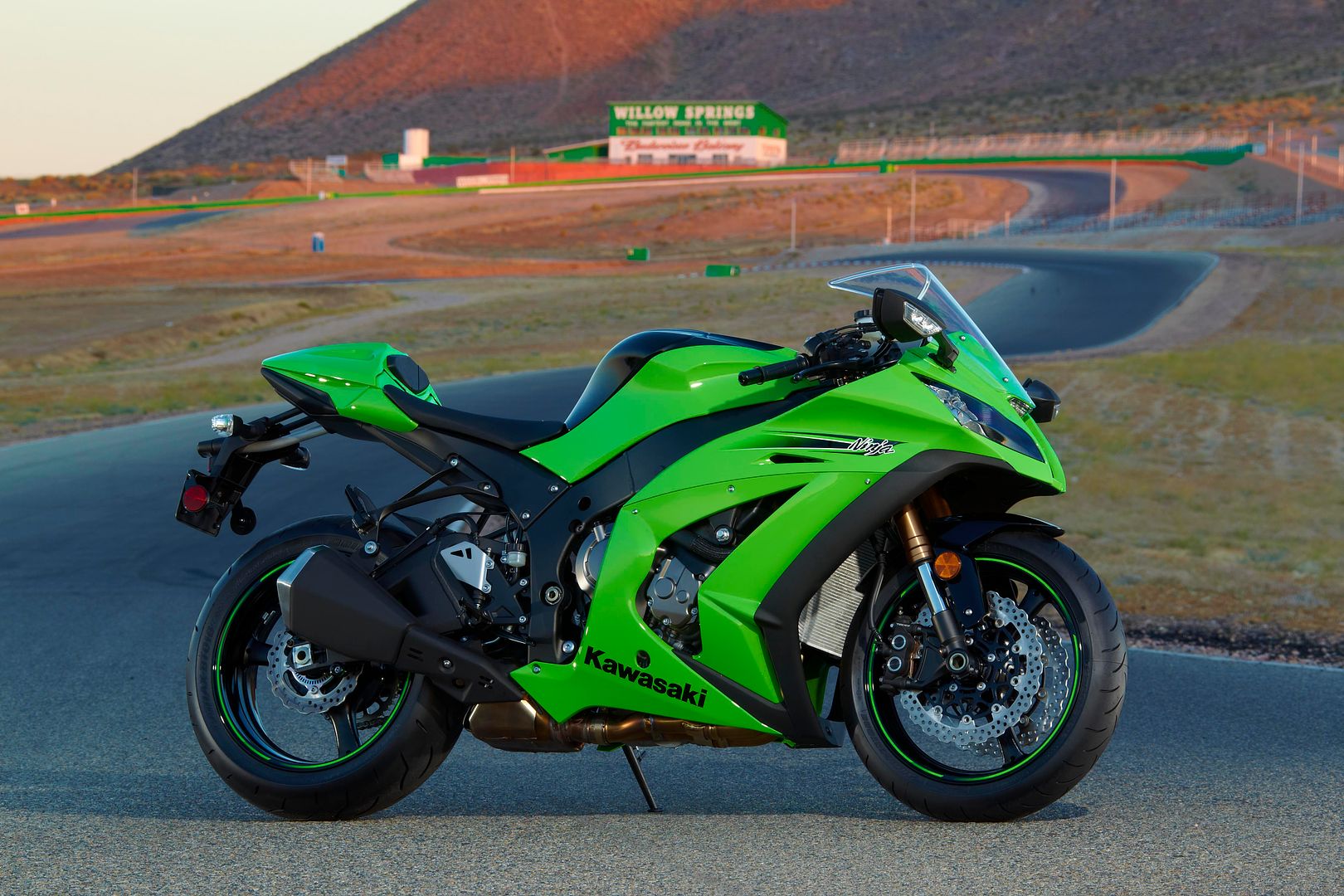
|
|
|

|
|
|
#2 |
|
Canyon Carver
Join Date: Nov 2009
Location: FLooRi.D.A.
Moto: gsx-r750
Posts: 378
|
Features and Benefits
New for 2011 – Totally redesigned DOHC, 16-valve, inline-four engine makes more – and more controllable – power than ever before – Stronger camshafts, pistons and crankshaft maintain legendary Kawasaki reliability in the face of additional horsepower – All-new S-KTRC electronic traction control system comes directly from MotoGP and allows racers to explore the edge of traction more successfully for better drive off the corners and faster laps – All-new ECU electronics also include a Power Mode system, which allows riders to pick between three power modes for changing conditions – Revised transmission shaft layout raises the engine’s center of gravity slightly for better mass centralization – Newly designed titanium-header exhaust system – Revised fuel injection system features larger throttle bodies and dual injectors – All-new aluminum twin-spar frame is lighter and offers optimal flex characteristics for the best possible handling – 43mm Big Piston Fork (BPF) is lighter than a conventional design and offers improved action and response – Redesigned Horizontal Back-link rear suspension offers better wheel control and improved mass centralization, all of which improves stability and overall handling – Shock and linkage assemblies are now positioned above the swingarm, which frees space below it for a large exhaust sub-chamber, which allows a shorter (and lighter) muffler – Lighter and stronger three-spoke gravity-cast wheels minimize unsprung weight for exceptional handling quickness – Revised ergonomics offer a roomier cockpit, a slightly lower seat and adjustable footpegs – Revised chassis geometry – steeper rake, less trail, slightly raised CG – allows even sharper handling characteristics – 22-pound weight reduction compared to the 2010 machine – Radical new bodywork features more rounded edges and a revised ram-air intake – Mirrors integrate trick, LED turn signals and remove easily for track day use – Revised transmission gear ratios for better on-track performance – High visibility instrumentation includes an LED bar-graph tachometer and a full complement of LCD readouts to keep riders fully informed Key Features – All-new engine and chassis add up to more power and more control – All-new Sport-Kawasaki Traction Control (S-KTRC) continuously monitors wheel speed, throttle position, engine rpm and a host of other data to help ensure the optimal amount of traction – All-new Power Mode selector allows riders to select power level and power delivery – All-new aluminum frame has ideal strength and rigidity – All-new Big Piston Fork helps maintain composure under braking – All-new Horizontal Back-link rear suspension helps improve road holding, and helps deliver smoother suspension action – 2011 ZX™-10R is 22 pounds lighter than the 2010 model – Improved mass centralization – Slipper-type back-torque limiting clutch helps improve corner entry handling – All-new race-oriented instrumentation offers riders a wealth of information New-generation Liquid-cooled DOHC 998cc Inline-four Engine – All-new design is compact, narrow and lightweight, and features a revised internal transmission shaft layout that optimizes CG and engine placement in the frame – Stronger camshafts, crankshaft and pistons increase durability and are able to withstand the new engine’s prodigious power production – Larger intake valves (now 31mm), revised camshaft profiles and optimized port shapes help maximize power production and smooth power delivery – Cylinder bores are machined with a “dummy” head bolted in place, yielding improved bore circularity and precision; thusly, lower-tension piston rings can be used, reducing mechanical losses – Offset cylinder bores (relative to the crankshaft) are positioned 2mm toward the exhaust side of the engine, resulting in reduced lateral piston force at the point of maximum combustion pressure, reduced mechanical friction and lower piston loads – allowing the use of lighter pistons – Larger-diameter intake tappets (now 29mm) suit the higher-lift camshafts – New, chromoly camshafts (previously cast iron) receive a new nitriding process and lapping treatment to help cope with heavier valve spring pressure and enhance durability – New, harder crankshaft features stronger pins and journal fillets; gear teeth durability was also increased – Single-shaft secondary balancer was added to help reduce vibration, and its use allowed several vibration-damping parts to be simplified and lightened – Connecting rods are stronger overall to suit the increase in power – New ECU is dramatically lighter than the old unit and is small enough to be tucked away in a slot in the airbox assembly – A lighter battery replaces the old unit for even more weight savings – One-piece upper crankcase and cylinder casting saves weight and offers maximum rigidity – Low-friction oil pump reduces parasitic power loss – A lightweight radiator with tightly packed cores provides efficient engine cooling – A liquid-cooled aluminum oil cooler promotes high-efficiency heat dissipation – Intake and exhaust valves are titanium to reduce reciprocating weight and stress at high rpm Dual-injector Digital Fuel Injection – Larger throttle bodies (47mm vs. 43mm) help produce more power and improved throttle control – Secondary fuel injectors improve top-end power output and power characteristics at high rpm; the lower injectors are always on, while upper injectors come on as needed according to degree of throttle opening and engine rpm – Oval-shaped throttle bodies – larger for 2011 – allow precise throttle control and instant response – An Idle Speed Control (ISC) valve on the throttle body unit automatically adjusts idle speed for more stable operation; also contributes to easier starts and better off-idle throttle response Sport-Kawasaki Traction Control – S-KTRC – A highly sophisticated electronic system based on actual Kawasaki MotoGP experience that’s designed to maximize forward motion by allowing racers to ride closer to the edge of traction – The system, anchored by an all-new Electronic Control Unit (ECU), crunches a wide range of data, including throttle position, wheel speed, engine rpm, wheel slippage and acceleration, with help from a speed sensor fitted to each wheel – The quickest acceleration requires a certain amount of wheel slippage, so to optimize traction, S-KTRC actually allows for optimum wheelspin – Using complex analysis, the system is able to predict when traction conditions are about to become unfavorable. By acting before slippage exceeds the range for optimal traction, the system can quickly and smoothly reduce power slightly so the wheel regains traction – S-KTRC confirms conditions 200 times per second and governs ignition, which allows extremely quick response to changing conditions – Riders can choose between three operational modes, depending on skill level and conditions – A level meter on the LCD instrument panel displays how much electronic intervention the system is providing, in real time Ram-air Intake – A highly efficient and more forward-positioned ram air intake is designed for lower intake noise, higher intake efficiency and thusly more power – Redesigned and larger airbox (now 9 liters instead of 8) with a new filter element improves breathing and power – Oval-section intake funnels promote non-turbulent flow at all rpm Titanium Exhaust System – All-new titanium-header exhaust system with hydroformed header pipes and small, lightweight muffler assembly uses a larger-volume pre-chamber that houses two catalyzers for reduced emissions and sound – Headers have nearly identical specs to their roadracing counterparts, which makes it easier for riders to increase track performance with the simple addition of a less-restrictive muffler; now there’s no need to replace the lightweight and race-spec header assembly – Dual catalyzers help the 2011 ZX-10R meet strict U.S. and Euro III exhaust emissions standards Six-speed Transmission – Race-style cassette transmission allows simple trackside gearing changes to suit individual circuits – With the revised engine shaft layout, the “cassette” is located high enough that it can be accessed without having to drain engine oil – Fine-tuned primary and final reduction ratios minimize rear end movement (squat/lift) during acceleration and deceleration. The more composed rear end action allows more freedom with suspension settings – Closer-ratio 4th, 5th and 6th gears complement the new ZX-10R’s circuit performance – Overall gear ratios suit the power characteristics for ideal power delivery in all rpm ranges – An adjustable back-torque limiting clutch facilitates smooth downshifts, a main contributor to stability under heavy braking Chassis / Frame – All-new aluminum-alloy frame connects the swingarm pivot with the steering head more directly, and offers optimal flex and rigidity characteristics for balanced handling on street or track – Revised chassis geometry incorporates slightly steeper rake (0.5 degree) and a bit less trail (3mm). The result is more weight on the front wheel, which allows sharper steering characteristics and crisper handling with no corresponding tradeoff in chassis stability at speed – Frame is an all-cast construction of only seven pieces, which allowed engineers much design freedom, including minimizing wall thicknesses while providing adequate strength and optimized rigidity – Fewer frame pieces mean fewer welds, which contributes to more pleasing aesthetics – More front end weight also aids aggressive, on-the-gas corner exits, as there is less tendency to wheelie – Modifying or removing the exhaust pre-chamber (for racetrack applications only) enables two chain links to be removed, which offers riders the opportunity to alter chassis geometry by shortening the wheelbase by up to 16mm to suit different track layouts – Like the frame, the alloy swingarm is an all-cast design, with just three pieces – Narrow subframe layout contributes to the compact and slim tail section Horizontal Back-link Rear Suspension – All-new design positions the shock and linkage above the swingarm – The new design offers a host of benefits, including improved road-holding, smoother suspension action (especially in the final third of the stroke range), increased stability and feedback when cornering, and improved mass centralization – The design also frees space under the swingarm for a larger exhaust pre-chamber, which allows the use of a shorter and lighter muffler assembly – The design also positions the shock’s upper link (mounted to the frame’s upper cross member) further from the swingarm pivot, helping to spread out the load and contribute to enhanced overall frame rigidity and chassis balance – The fully adjustable shock features a piggyback reservoir and dual (high- and low-speed) compression damping, which enables fine tuning for racing or track-day use – Between the Big Piston Fork (BPF) and new Back-link suspension system, pitch control during aggressive riding is minimized, which contributes to added rider control and faster lap times – Minimal effect from exhaust heat due to the new design translates to more stable damping performance Big Piston Fork (BPF) – The Big Piston Fork (BPF) fitted to the 2011 Ninja® ZX-10R features 43mm inner tubes and is one of the contributing factors to the new bike’s enhanced composure under braking – Compared to a cartridge-type fork of the same size, the BPF features a main piston almost twice the size as the piston on the previous ZX-10R: 39.6mm vs. 20mm – Oil inside the BPF acts on a surface area almost four times the size of a conventional fork’s. The larger surface area allows damping pressure to be reduced while ensuring that damping force remains the same – Reducing damping pressure allows the inner fork tube to move more smoothly, which is especially noticeable at the initial part of the stroke. The result is greater control as the fork compresses and very calm attitude change as vehicle weight shifts forward under braking, and thus greater chassis stability on corner entry – Because the BPF eliminates many of the internal components of a traditional cartridge fork, construction is simplified and overall fork weight is reduced – Compression and rebound damping adjustments are located at the top of each fork tube, while preload is now at the bottom Race-spec Steering Damper – An adjustable twin-tube Öhlins steering damper is standard. The second tube acts like a reservoir, allowing the internals to ensure stable damping and excellent feedback even under racing conditions Advanced Braking System – Tokico radial-mount brake calipers use dual pads and offer a superb initial bite, increased control, progressive feel and a high degree of feedback to the rider – A radial-pump front master cylinder provides the ultimate in front brake feel and feedback – A pair of 5.5mm thick, 310mm petal discs provides the heat dissipation needed to maintain brake feel and responsiveness during extended heavy use – A 220mm rear petal disc gripped by a single-piston caliper provides excellent feel and feedback Three-spoke Cast Aluminum Wheels – New gravity-cast alloy wheels feature a three-spoke design that’s lighter than previous hoops by 330 grams (0.73 pound) up front and nearly 500 grams (1.1 pounds) in back – Lighter wheels reduce unsprung weight, which allows the suspension system to work more efficiently Ergonomics – Fine-tuned rider accommodations feature a lower seat (by 17mm), adjustable footpegs moved slightly lower (by 5mm) and forward (by 2mm), and clip-ons with a bit less downward angle – Lower seat makes it easier to reach the ground – Newly shaped fuel tank offers an even better ergonomic fit with the rider’s forearms and inner thighs when riding – Adjustable foot pegs can be lowered an additional 15mm when street riding or touring Advanced Aerodynamic Bodywork – A total body redesign results in a lighter, more compact and even sexier shape, with more curved – instead of “edged” – surfaces – High-quality fit and finish, and superb attention to detail, are evident front to back – Larger ducting aids engine heat dissipation – Line-beam headlights enable the fairing to be shorter, which furthers the compact, aggressive styling – LED three-bulb position lamp at the top of the new ram air duct offers enhanced visibility to drivers and pedestrians – Fairing-mounted mirrors feature integrated, LED-type turn signals – Turn signals are electrically connected via couplers, which allows easy mirror removal for track day riding – Compact tail section includes an elegant, nine-bulb taillight – Taillight and turn-signal stalks are mounted on a rear fender assembly that’s easily removable for track day riding Advanced Electronic Instrumentation – All-new instruments feature a high-visibility bar-graph LED tachometer positioned above a multi-window LCD info panel that offers riders a massive quantity of information – The tachometer also functions as a shift indicator: LEDs flash when the pre-set rpm is reached, and riders can set shift rpm according to preference – The multi-function LCD features two display modes: Standard and Race. Switching to Race Mode alters the Speed display by changing it to Gear Position, and by changing the Clock display to Speed – Additional functions include odometer, dual trip meters, average fuel consumption, instant fuel consumption, Power Mode (x3), S-KTRC (x4), S-KTRC level indicator, low fuel indicator, Economical Riding indicator (shows most favorable fuel consumption), water temperature and a host of indicator lamps Code:
Engine: Four-stroke, liquid-cooled, DOHC, four valves per cylinder, inline-four Displacement: 998cc Bore x stroke: 76.0 x 55.0mm Compression ratio: 13.0:1 Fuel system: DFI® with four 47mm Keihin throttle bodies with oval sub-throttles, two injectors per cylinder Ignition: TCBI with digital advance and Sport-Kawasaki Traction Control (S-KTRC) Transmission: Six-speed Final drive: Chain Rake / trail: 25.0 degrees / 4.33 in. Front tire: 120/70 ZR17 Rear tire: 190/55 ZR17 Wheelbase: 56.1 in. Front suspension / wheel travel: 43mm inverted Big Piston Fork (BPF) with DLC coating, adjustable rebound and compression damping, spring preload adjustability / 4.7 in. Rear suspension / wheel travel: Horizontal Back-link with gas-charged shock and top-out spring, stepless, dual-range (low-/high-speed) compression damping, stepless rebound damping, fully adjustable spring preload / 4.9 in. Front brakes: Dual semi-floating 310mm petal discs with dual four-piston radial-mount calipers Rear brakes: Single 220mm petal disc with aluminum single-piston caliper Overall length: 81.7 in. Overall width: 28.2 in. Overall height: 43.9 in. Seat height: 32.0 in. Curb weight: 436.6 lbs. Fuel capacity: 4.5 gal. Color choices: Lime Green / Ebony, Ebony / Flat Ebony MSRP: $13,799 Warranty: 12 Months |
|
|

|
|
|
#3 |
|
Canyon Carver
Join Date: Nov 2009
Location: FLooRi.D.A.
Moto: gsx-r750
Posts: 378
|
 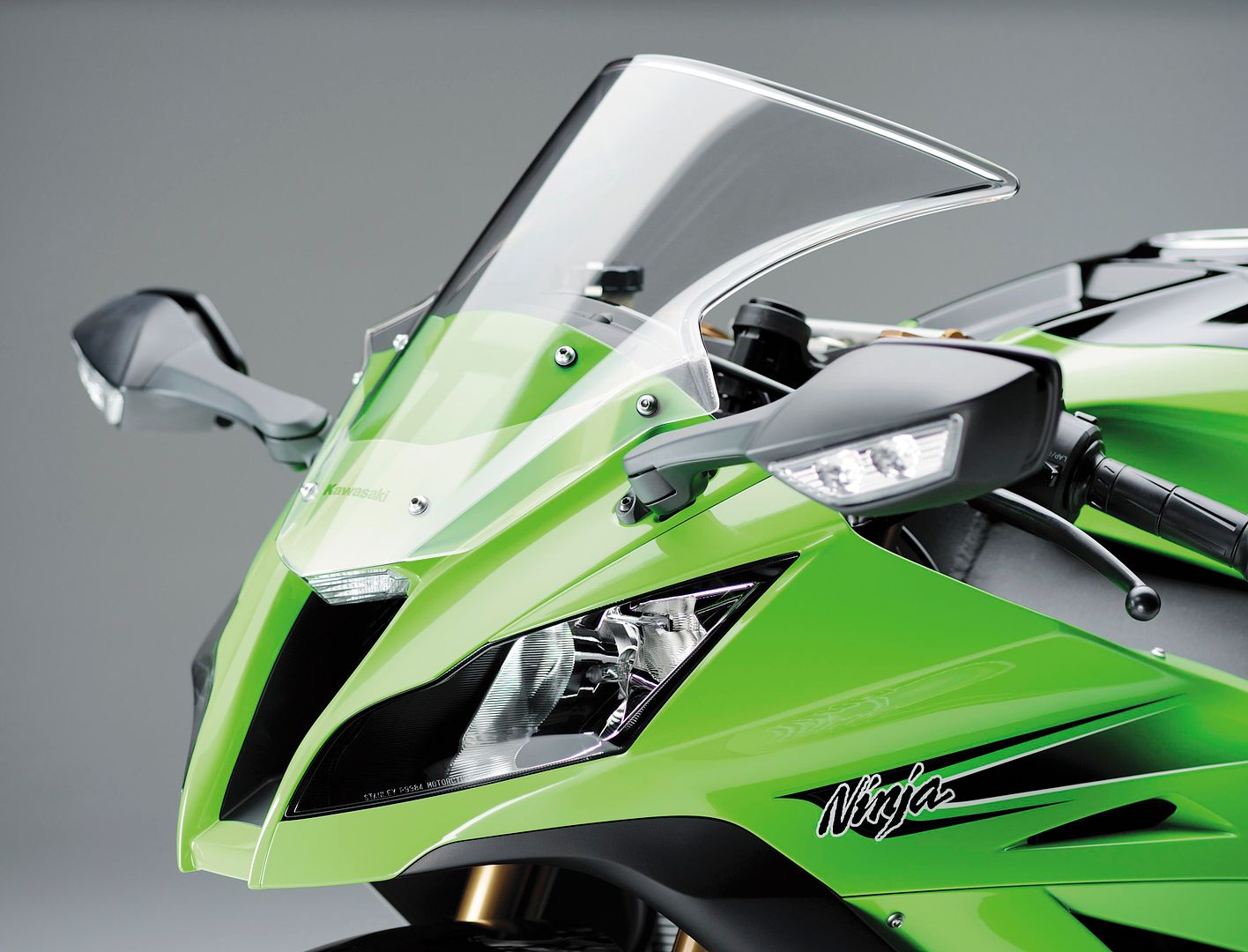 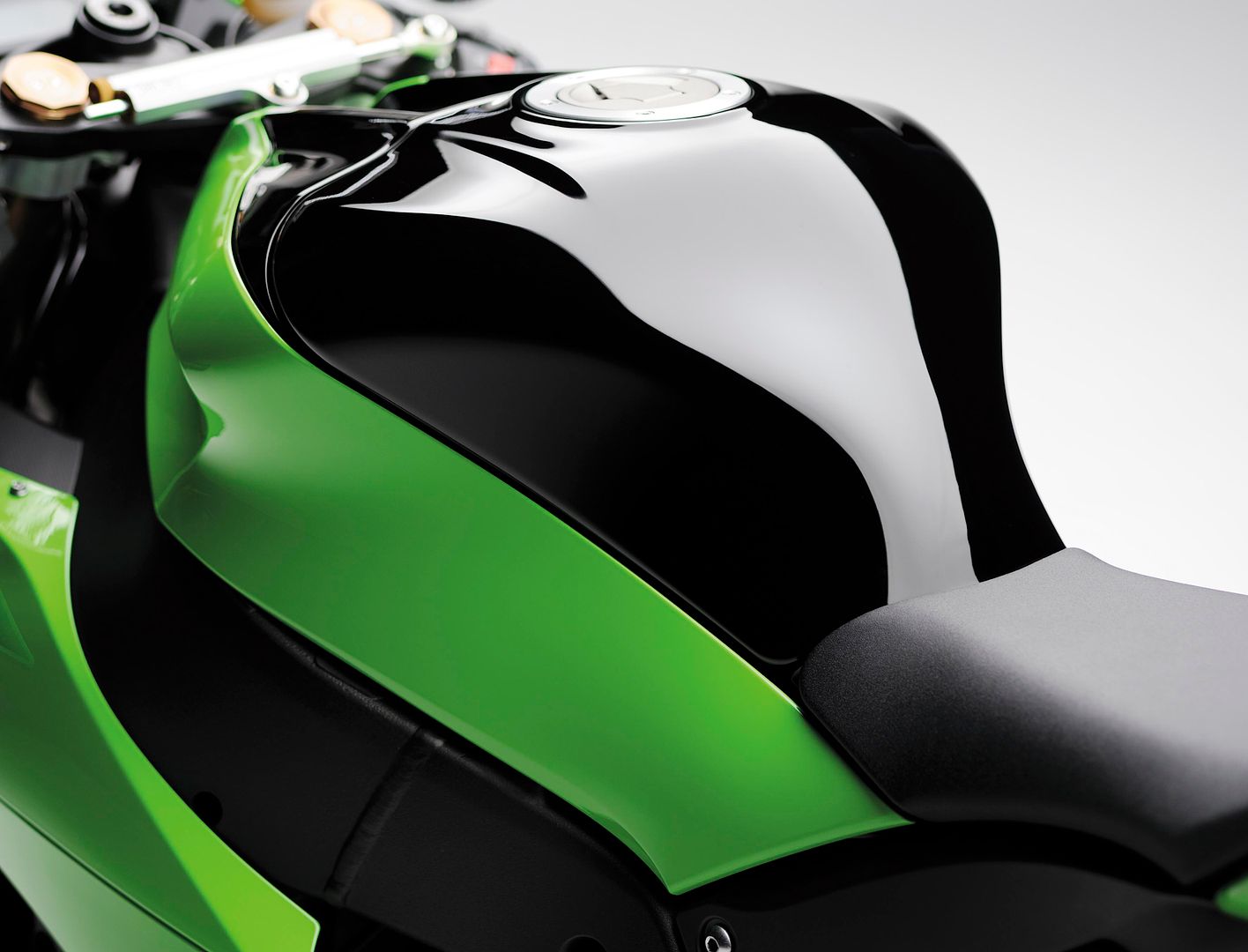 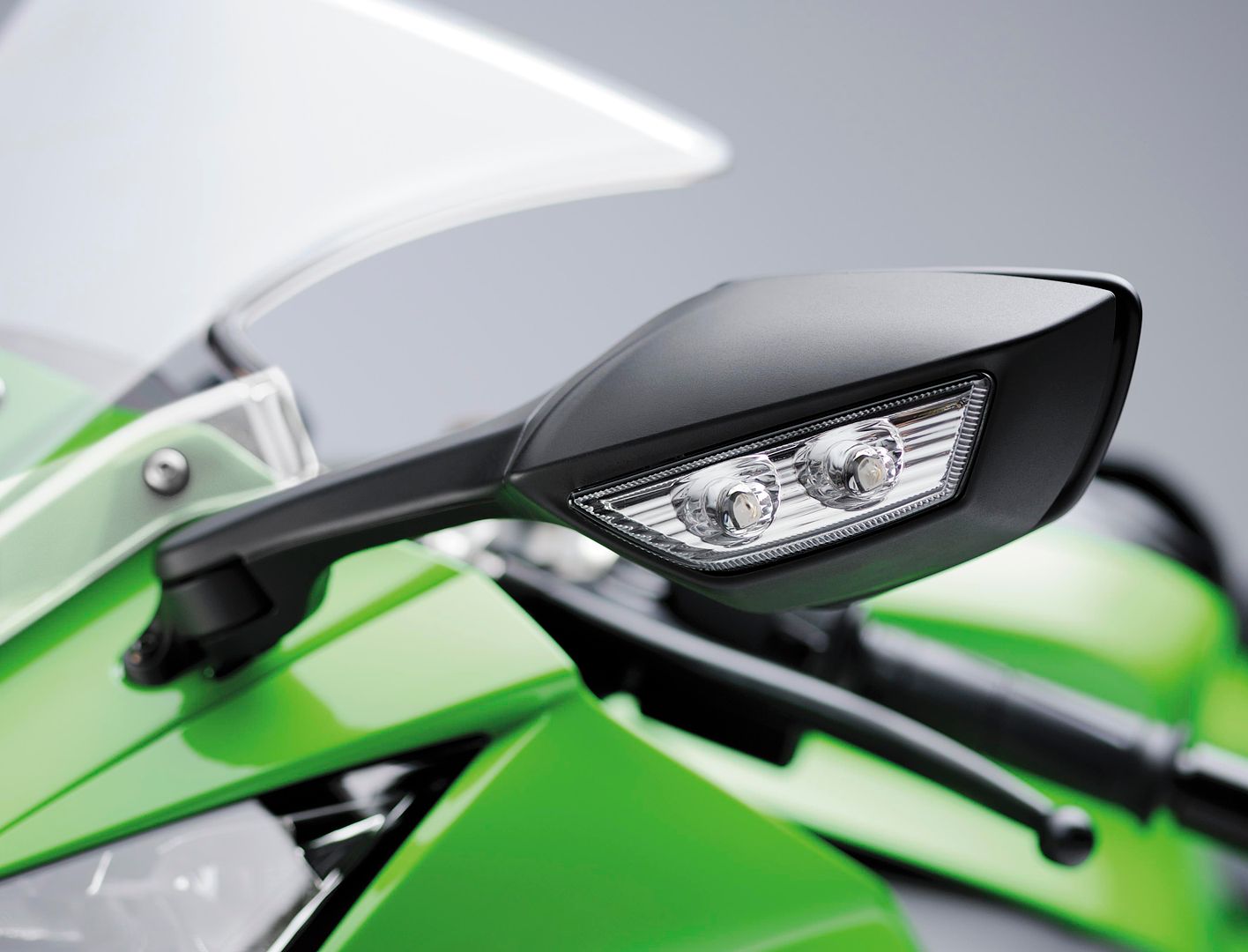 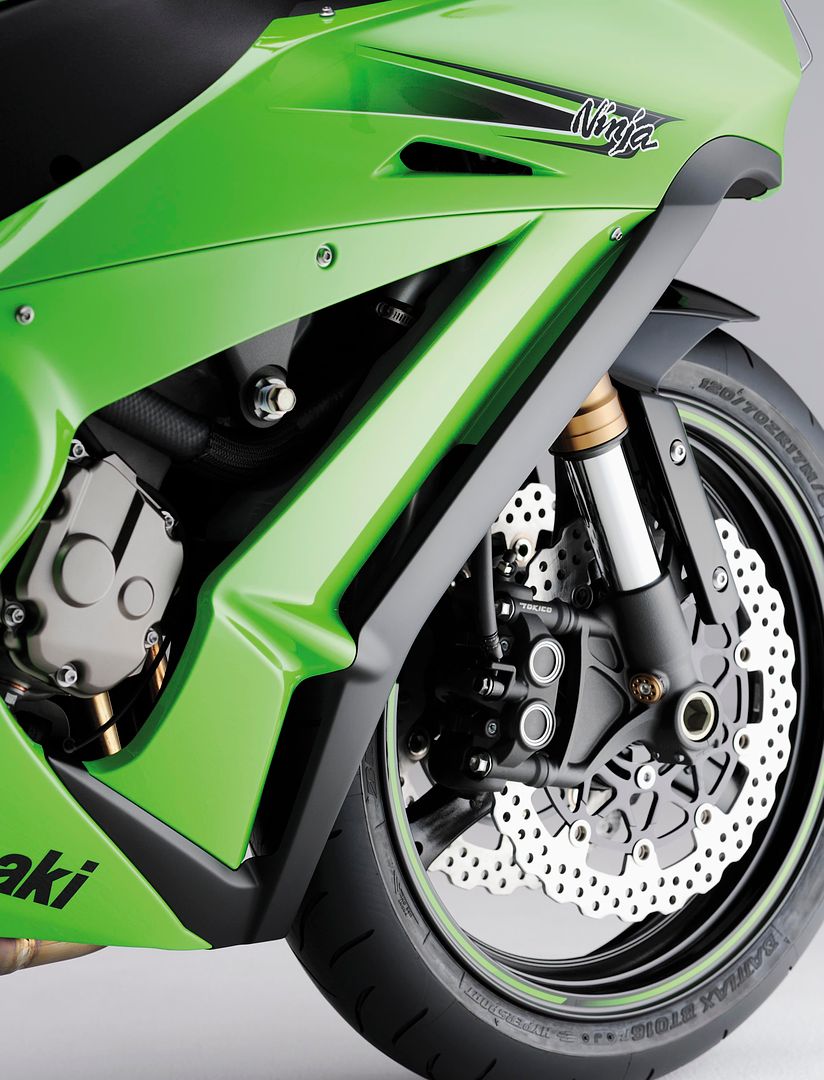
|
|
|

|
|
|
#4 |
|
Canyon Carver
Join Date: Nov 2009
Location: FLooRi.D.A.
Moto: gsx-r750
Posts: 378
|
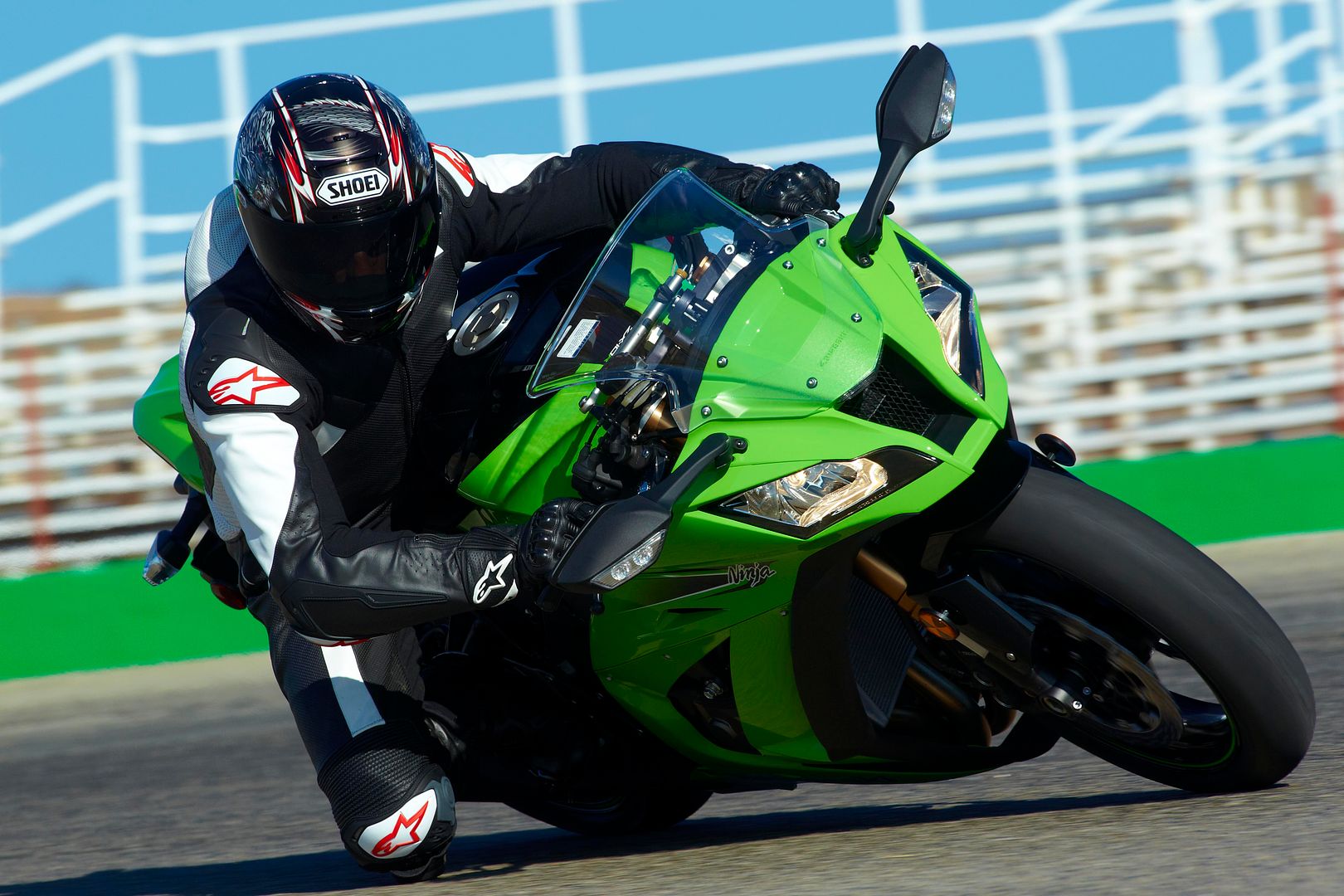 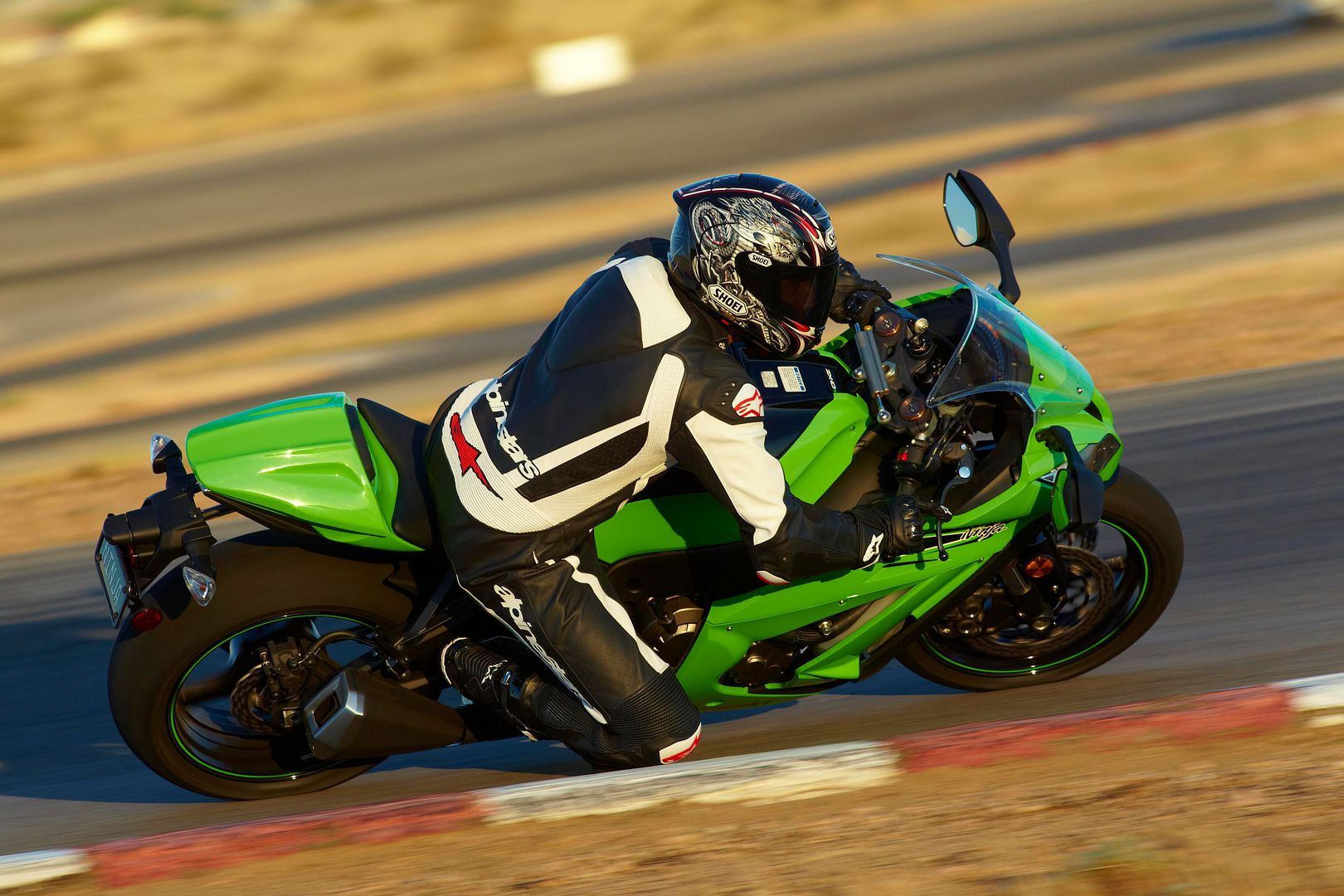 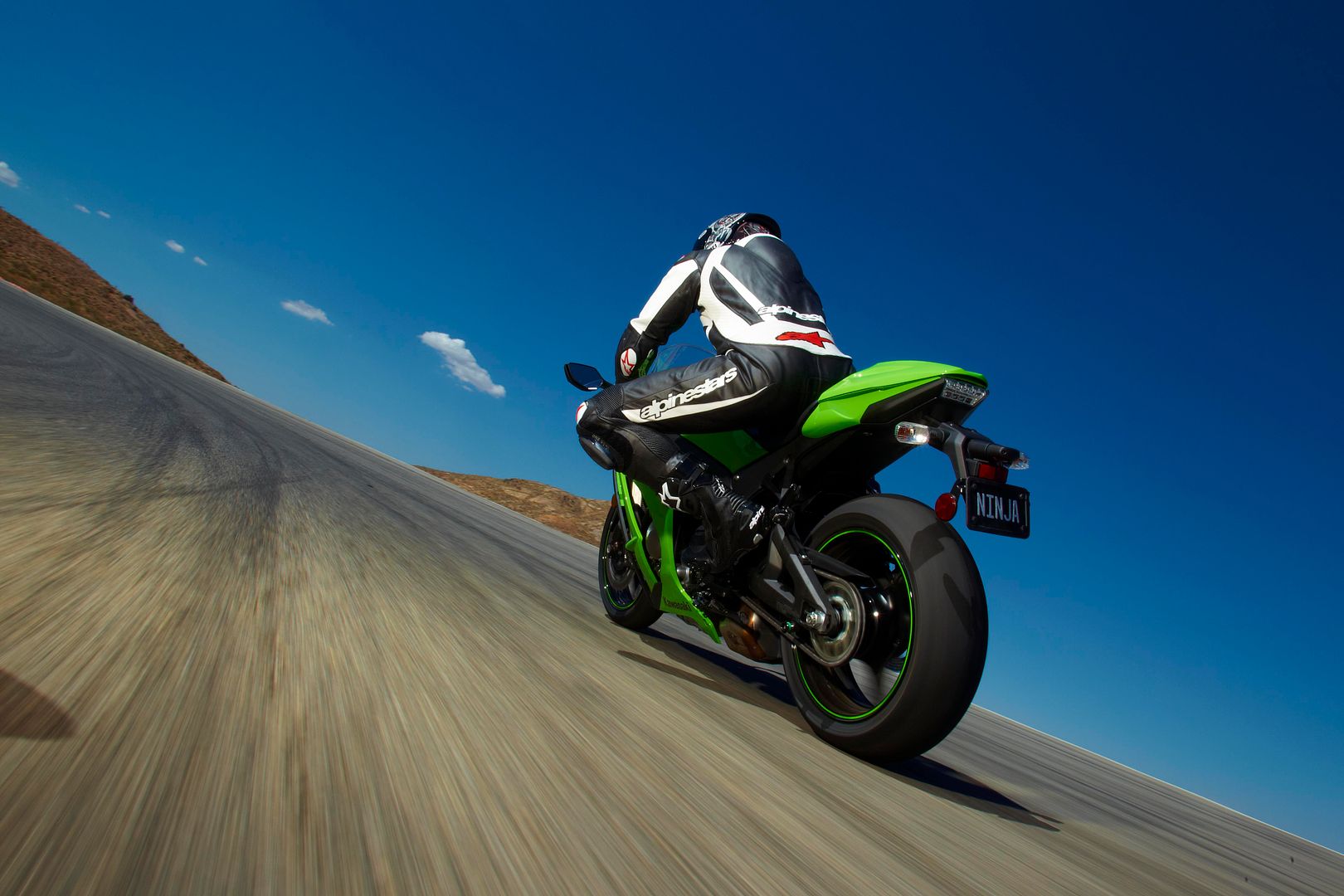 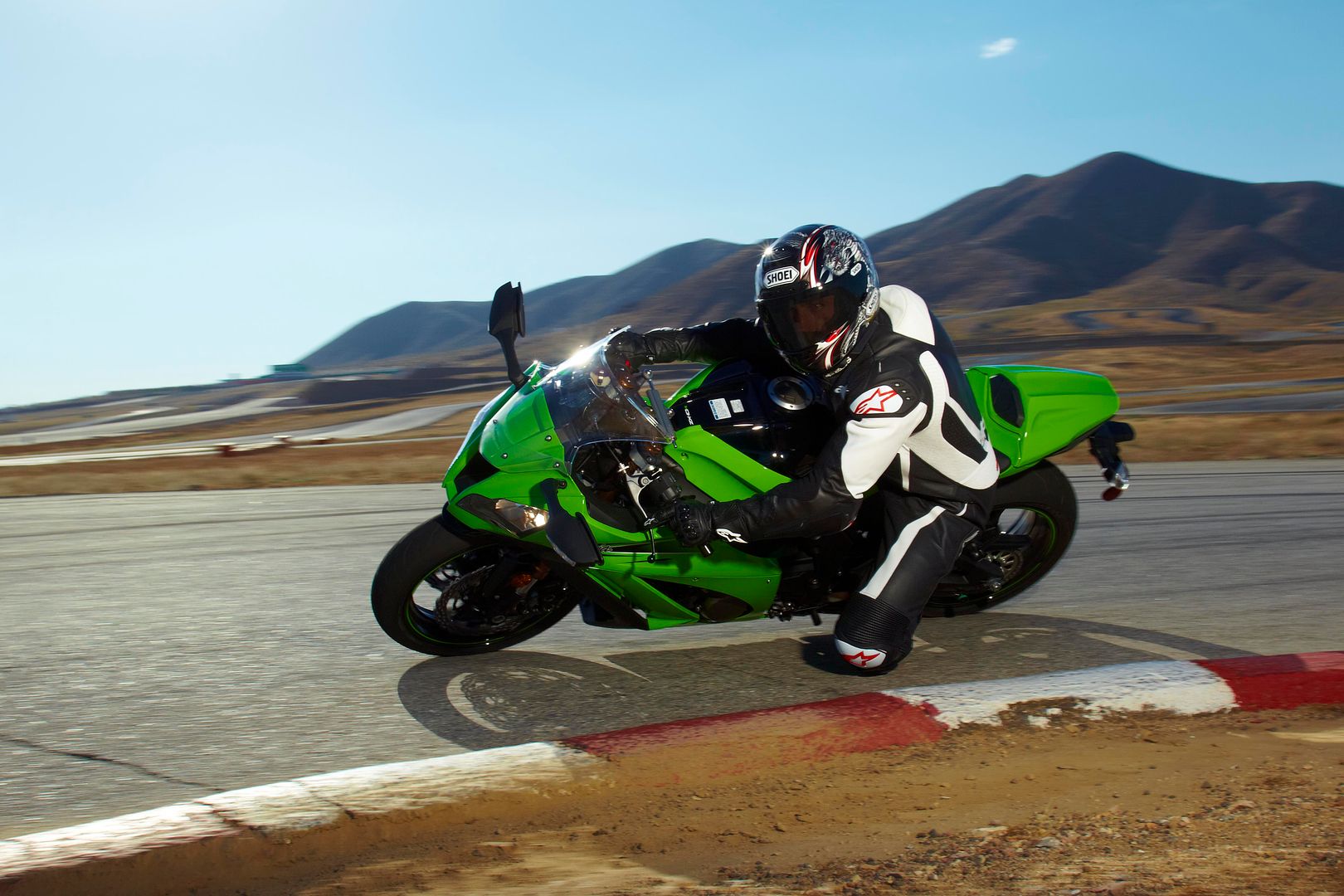 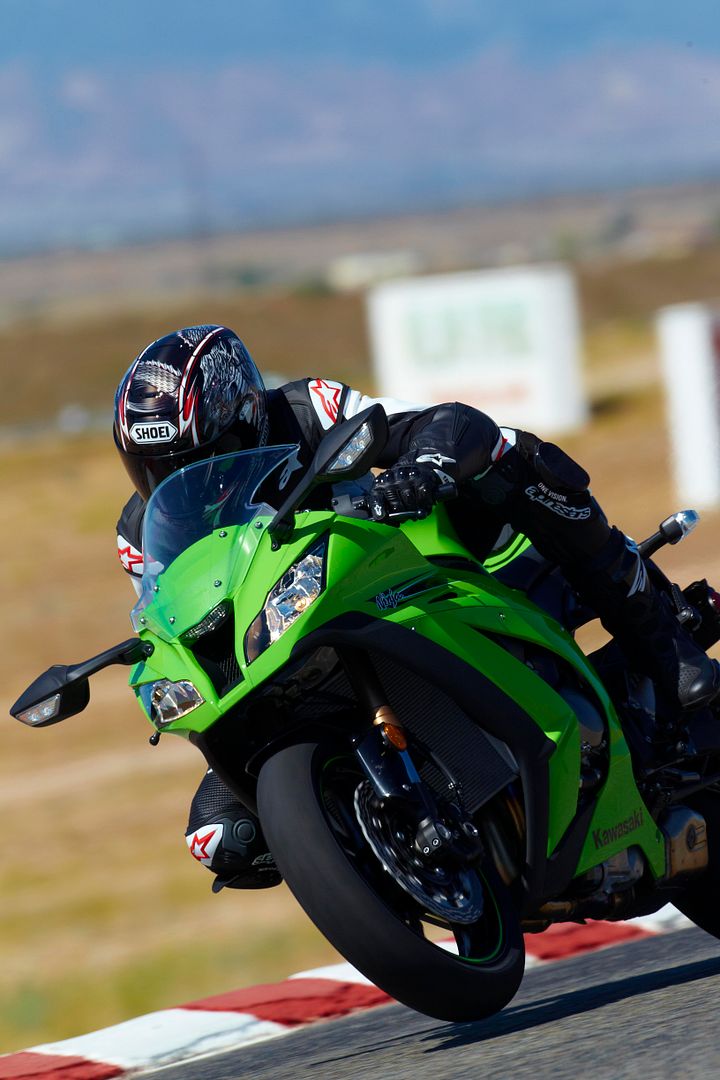
|
|
|

|
|
|
#5 |
|
Canyon Carver
Join Date: Nov 2009
Location: FLooRi.D.A.
Moto: gsx-r750
Posts: 378
|
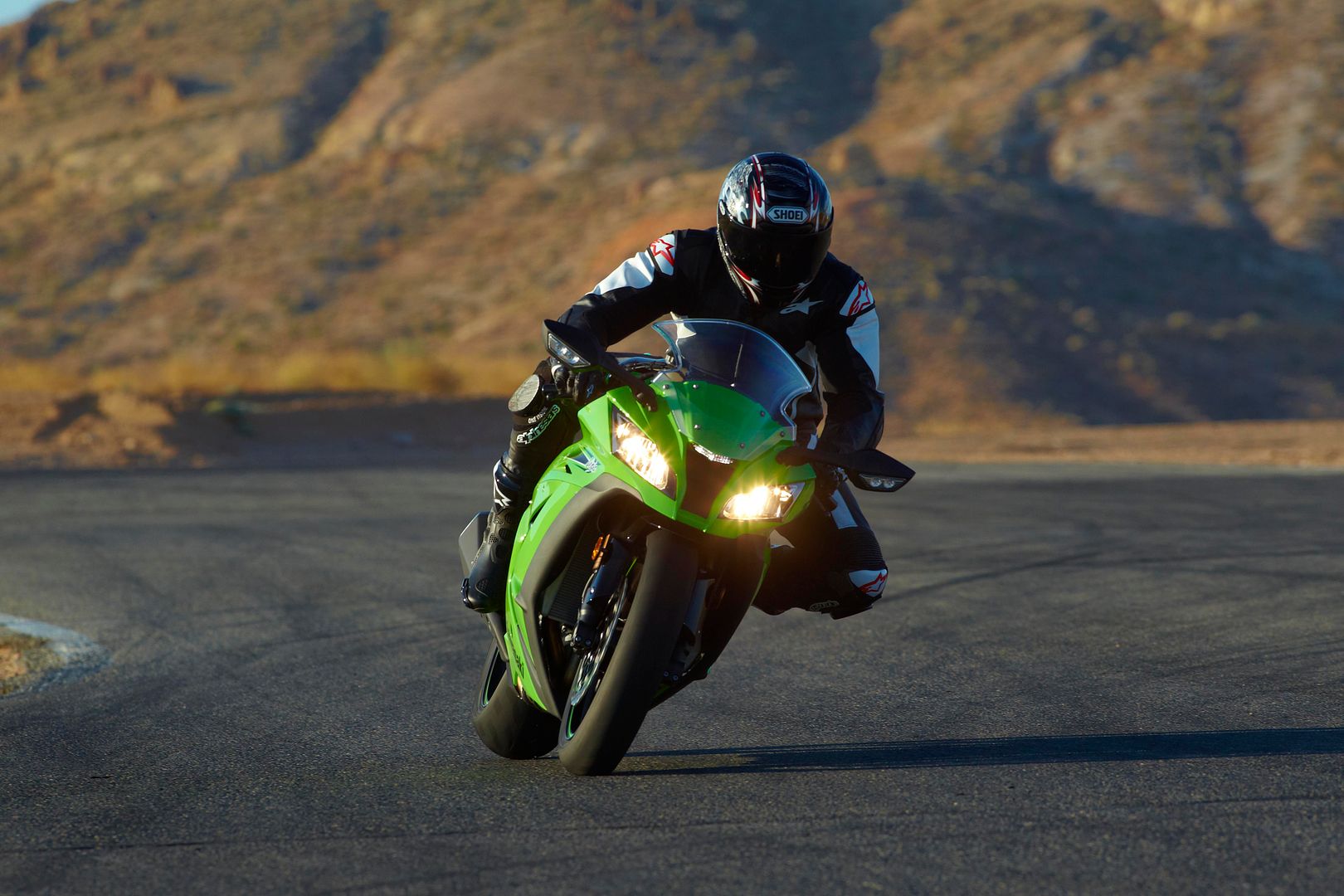 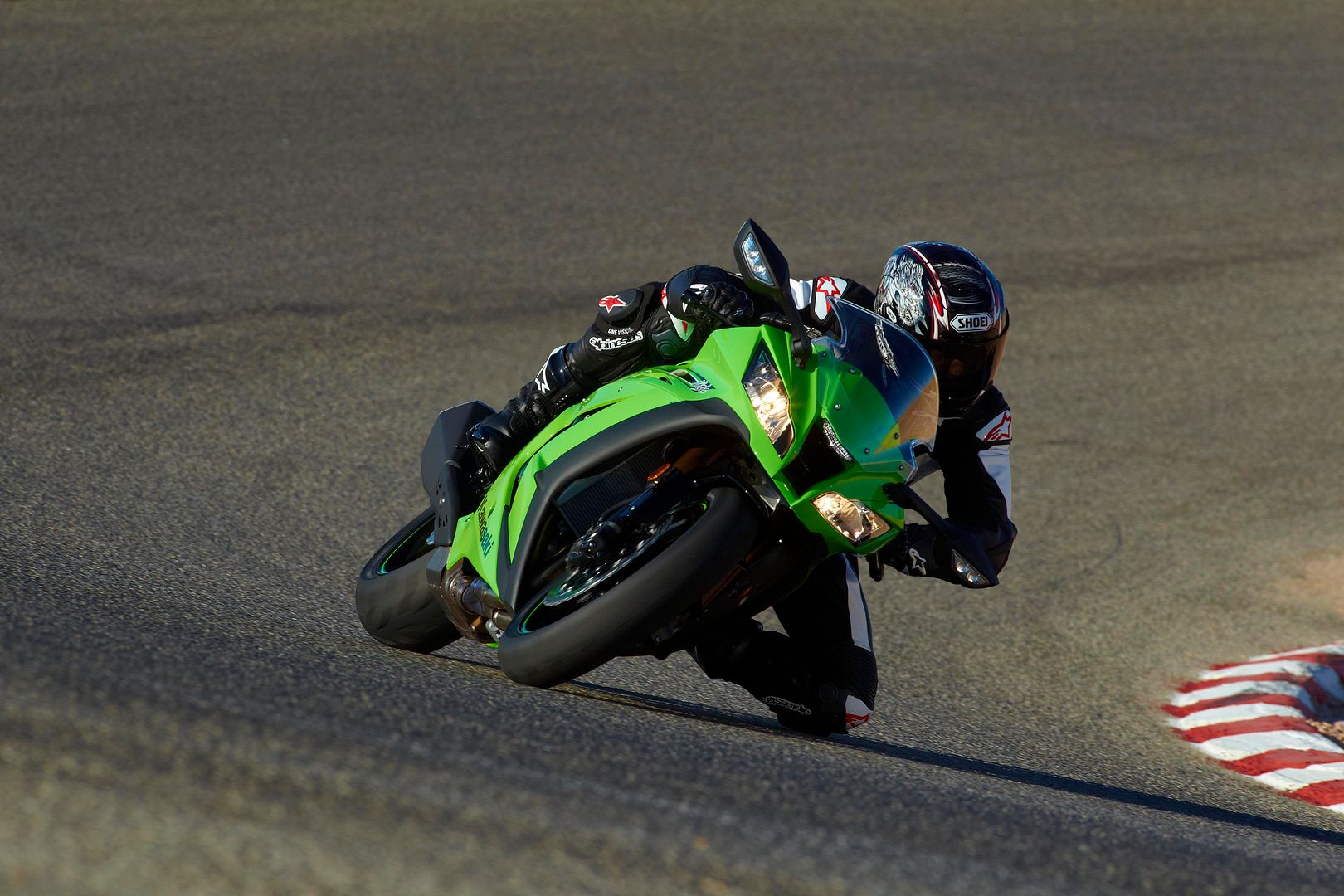  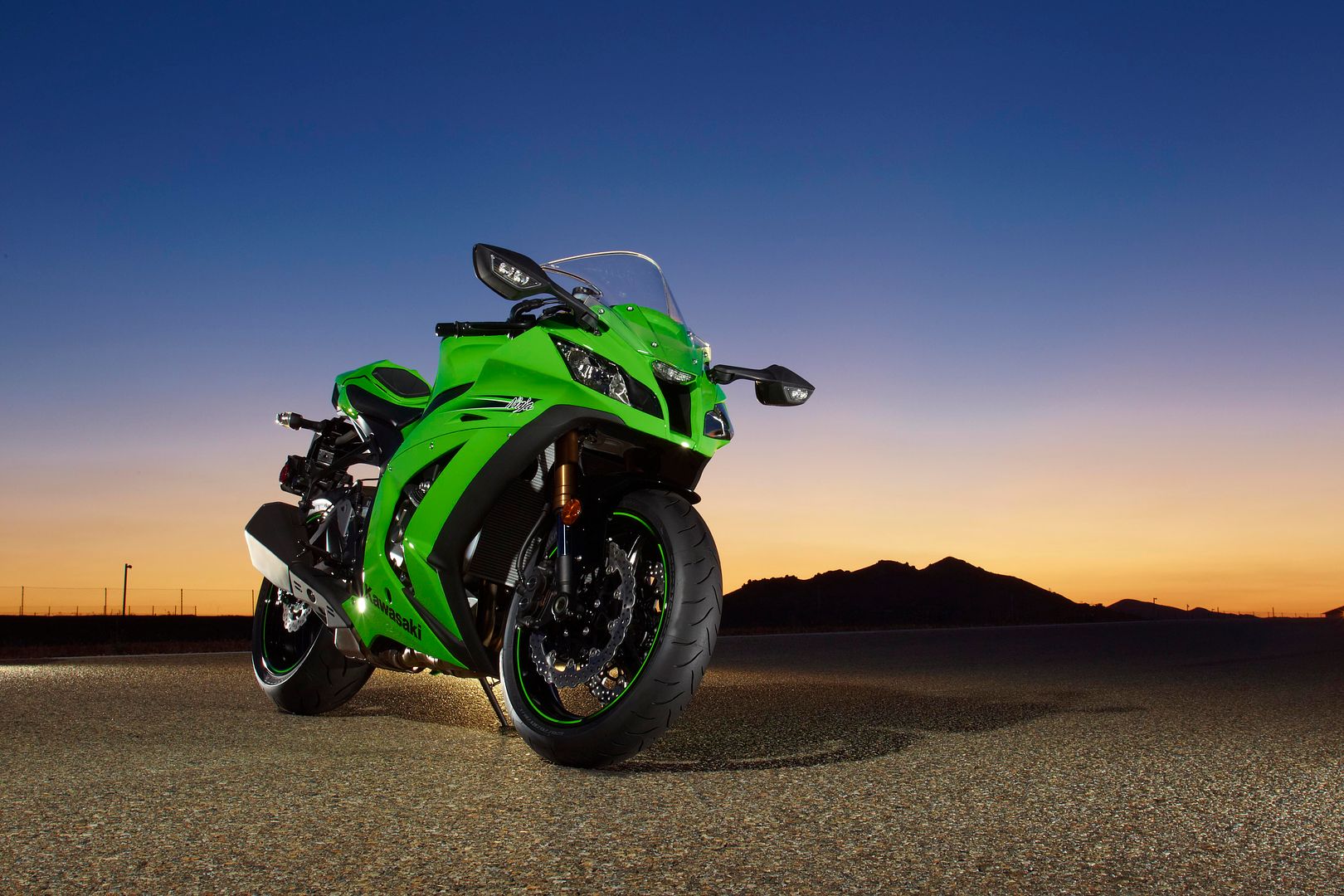
|
|
|

|
|
|
#6 |
|
token jewboy
Join Date: Nov 2008
Moto: CBR 900, KLR ugly ass duckling, Gas Man
Posts: 10,799
|
cool, the headlights are a turnoff though, not sure I like the direction kawi is taking, but the guage cluster looks awesome
__________________

|
|
|

|
|
|
#7 |
|
Canyon Carver
Join Date: Nov 2009
Location: FLooRi.D.A.
Moto: gsx-r750
Posts: 378
|
Yeah, the headlights look weird at an angle, but looking at it head-on I like it. I think the bike looks hot in person. In the pictures it's easy to focus on things you don't like about it, but when you are actually looking at one, it comes together pretty well and is a good looking bike.
|
|
|

|
|
|
#8 |
|
Chaotic Neutral
Join Date: Feb 2008
Location: Cherry Hill NJ
Moto: GV1200 Madura, Hawk gt
Posts: 13,992
|
i want to hump it
__________________
TWF Post whore #6 |
|
|

|
|
|
#9 |
|
RIP REX
 Join Date: Feb 2008
Location: Murfreesboro, TN
Moto: 2008 1125R
Posts: 7,467
|
i think it looks like the best bike out imho
|
|
|

|
|
|
#10 | |
|
125GP Champion
Join Date: Aug 2008
Location: Worthington, OH
Moto: Empty Garage
Posts: 3,418
|
Quote:
 
__________________
*Coming soon? 2010 Ducati Monster 696 - Sold 1984 Honda VF500F - Sold 1999 Yamaha R6 - Sold Last edited by Porkchop; 10-13-2010 at 09:27 PM.. |
|
|
|

|
 |
| Bookmarks |
|
|